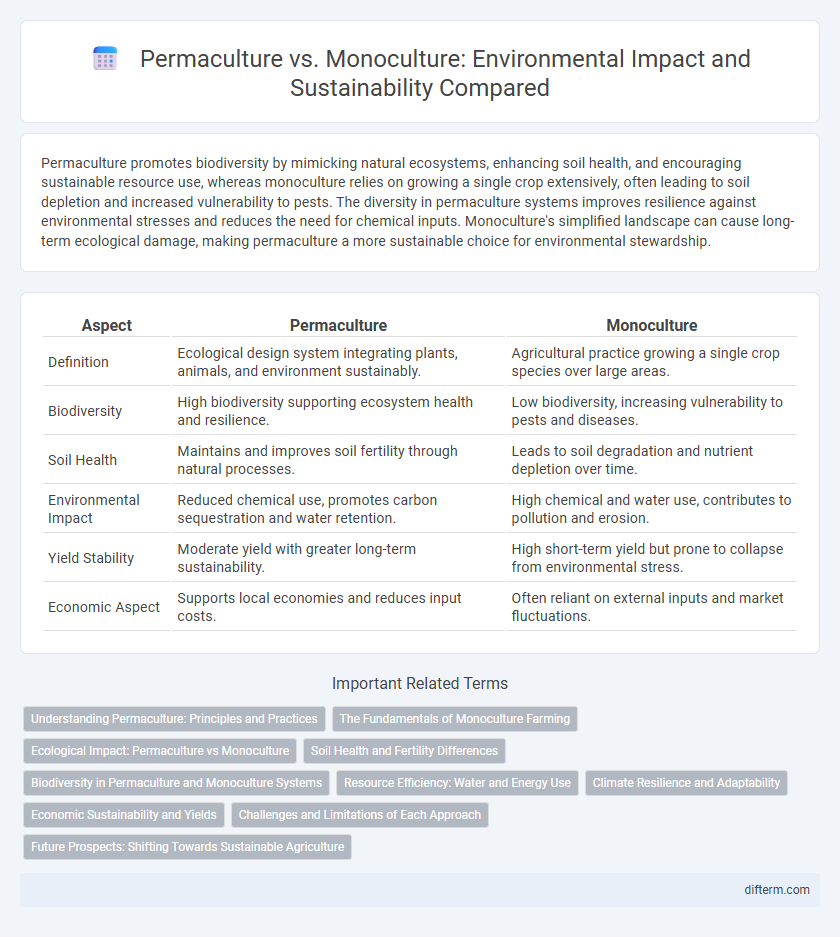Permaculture promotes biodiversity by mimicking natural ecosystems, enhancing soil health, and encouraging sustainable resource use, whereas monoculture relies on growing a single crop extensively, often leading to soil depletion and increased vulnerability to pests. The diversity in permaculture systems improves resilience against environmental stresses and reduces the need for chemical inputs. Monoculture's simplified landscape can cause long-term ecological damage, making permaculture a more sustainable choice for environmental stewardship.
Table of Comparison
| Aspect | Permaculture | Monoculture |
|---|---|---|
| Definition | Ecological design system integrating plants, animals, and environment sustainably. | Agricultural practice growing a single crop species over large areas. |
| Biodiversity | High biodiversity supporting ecosystem health and resilience. | Low biodiversity, increasing vulnerability to pests and diseases. |
| Soil Health | Maintains and improves soil fertility through natural processes. | Leads to soil degradation and nutrient depletion over time. |
| Environmental Impact | Reduced chemical use, promotes carbon sequestration and water retention. | High chemical and water use, contributes to pollution and erosion. |
| Yield Stability | Moderate yield with greater long-term sustainability. | High short-term yield but prone to collapse from environmental stress. |
| Economic Aspect | Supports local economies and reduces input costs. | Often reliant on external inputs and market fluctuations. |
Understanding Permaculture: Principles and Practices
Permaculture emphasizes sustainable agricultural practices by mimicking natural ecosystems through principles like diversity, regenerative soil management, and water conservation. Unlike monoculture, which relies on single-crop cultivation, permaculture integrates crops, animals, and natural resources to create resilient, self-sustaining environments. Core techniques include polyculture planting, composting, and rainwater harvesting, fostering long-term ecosystem health and reducing dependence on synthetic inputs.
The Fundamentals of Monoculture Farming
Monoculture farming involves cultivating a single crop species over a large area, optimizing planting, harvesting, and pest control techniques for uniformity and efficiency. This agricultural method heavily relies on synthetic fertilizers, pesticides, and irrigation, often leading to soil degradation, reduced biodiversity, and increased vulnerability to pests and diseases. Understanding the fundamentals of monoculture farming highlights its short-term productivity benefits versus long-term environmental sustainability challenges.
Ecological Impact: Permaculture vs Monoculture
Permaculture enhances biodiversity by integrating diverse plant species, fostering soil fertility, and supporting natural pest control, which creates a resilient ecosystem. Monoculture depletes soil nutrients, increases vulnerability to pests and diseases, and accelerates environmental degradation through heavy use of fertilizers and pesticides. The ecological impact of permaculture promotes sustainable land management, while monoculture often leads to reduced ecosystem services and long-term soil erosion.
Soil Health and Fertility Differences
Permaculture enhances soil health by promoting biodiversity, organic matter buildup, and natural nutrient cycling, which improves soil structure and fertility over time. In contrast, monoculture depletes soil nutrients through repetitive planting of a single crop, leading to increased erosion, reduced microbial diversity, and reliance on synthetic fertilizers. Sustainable soil management in permaculture supports long-term productivity and ecosystem resilience, while monoculture often results in soil degradation and diminished fertility.
Biodiversity in Permaculture and Monoculture Systems
Permaculture systems enhance biodiversity by integrating diverse plant species and creating habitats for beneficial insects, promoting ecological balance. Monoculture practices reduce biodiversity through extensive cultivation of a single crop, increasing vulnerability to pests and diseases. Higher biodiversity in permaculture supports soil health, water retention, and resilience against environmental stressors.
Resource Efficiency: Water and Energy Use
Permaculture systems maximize resource efficiency by mimicking natural ecosystems, enabling diverse plant species to enhance water retention and reduce energy inputs through synergistic relationships. Monoculture practices often require higher water volumes and energy-intensive irrigation and fertilization to sustain single-crop yields, leading to resource depletion and increased environmental stress. Efficient water cycling and energy conservation in permaculture contribute to sustainable agriculture and long-term ecosystem health.
Climate Resilience and Adaptability
Permaculture enhances climate resilience by mimicking natural ecosystems, promoting biodiversity and soil health, which improves water retention and reduces vulnerability to extreme weather events. Monoculture, with its single-species focus, often depletes soil nutrients and increases susceptibility to pests and climate stressors, leading to reduced adaptability. Integrating permaculture principles supports sustainable agricultural systems that better withstand climate variability and contribute to long-term environmental stability.
Economic Sustainability and Yields
Permaculture promotes economic sustainability by diversifying crops and reducing input costs, resulting in resilient yields over time. Monoculture often maximizes short-term yields but depends heavily on chemical fertilizers and pesticides, increasing economic vulnerability. Long-term permaculture systems enhance soil health and productivity, stabilizing income streams for farmers.
Challenges and Limitations of Each Approach
Permaculture faces challenges such as labor-intensive design and slower initial yields, while monoculture struggles with soil degradation, increased pest vulnerability, and reliance on chemical inputs. Permaculture's reliance on diverse plant interactions can complicate large-scale food production and market integration. Monoculture's high productivity comes at the cost of biodiversity loss and long-term sustainability issues.
Future Prospects: Shifting Towards Sustainable Agriculture
Permaculture promotes biodiverse ecosystems that enhance soil health, water retention, and resilience against climate change, offering a sustainable alternative to monoculture's resource-intensive methods. Future agricultural strategies increasingly favor permaculture principles to reduce environmental degradation, improve food security, and support regenerative practices. Transitioning from monoculture to permaculture can mitigate deforestation, soil erosion, and chemical dependency, aligning with global sustainability goals.
permaculture vs monoculture Infographic

 difterm.com
difterm.com